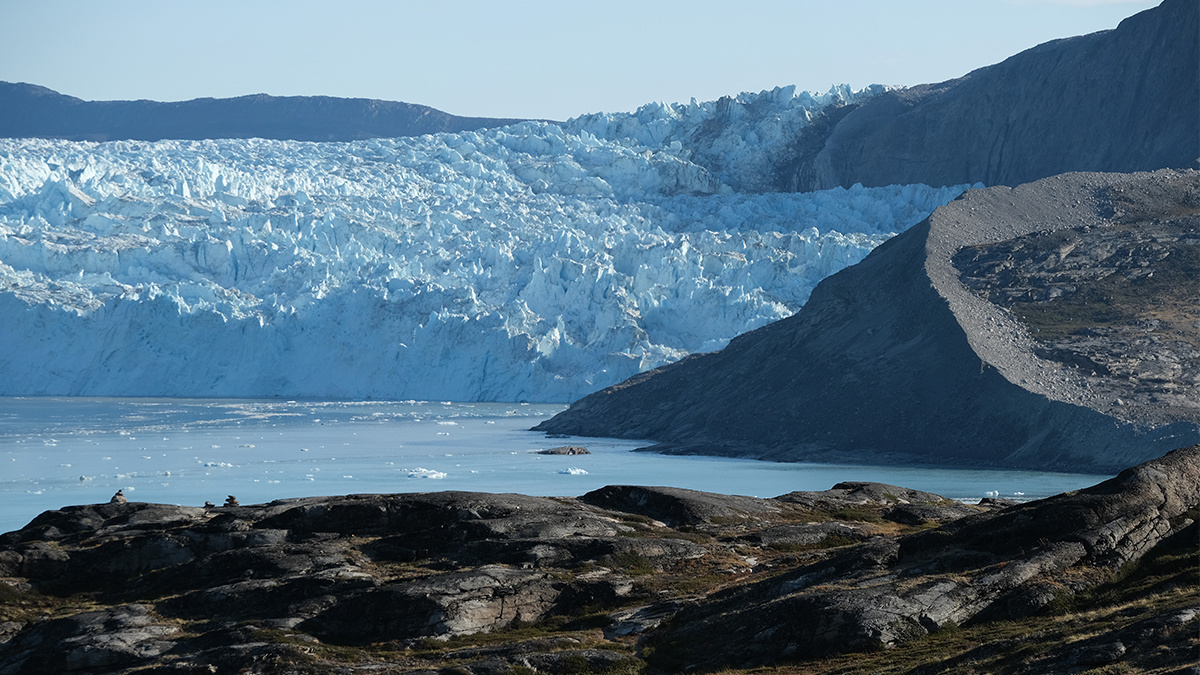
‘We Should Be Retreating Already From the Coastline,’ Scientist Suggests After Finding Warm Waters Below Greenland

The Eqip Sermia Glacier is seen behind a moraine left exposed by the glacier's retreat during unseasonably warm weather on Aug. 1 at Eqip Sermia, Greenland. Sean Gallup / Getty Images
Editor’s Note: This article includes a quote from Josh Willis, NASA oceanographer: “There is enough ice in Greenland to raise the sea levels by 7.5 meters, that’s about 25 feet, an enormous volume of ice, and that would be devastating to coastlines all around the planet,” said Josh Willis, a NASA oceanographer, to CNN. “We should be retreating already from the coastline if we are looking at many meters [lost] in the next century or two.” In 2019, a NASA study found, “In the scenario with no reduction of emissions, the study found that the entire Greenland Ice Sheet will likely melt in a millennium, causing 17 to 23 feet of sea level rise.” That report also states, “In the next 200 years, the ice sheet model shows that melting at the present rate could contribute up to 63 inches to global sea level rise, said the team led by scientists at the Geophysical Institute at the University of Alaska Fairbanks.” It appears Willis’s quote is accurate in terms of sea levels rising, but attributed it to a faster timeline than the NASA report.
Andrew Yang’s assertion that people move away from the coast at the last Democratic debate is the completely rational and correct choice for NASA scientists in Greenland.
“There is enough ice in Greenland to raise the sea levels by 7.5 meters, that’s about 25 feet, an enormous volume of ice, and that would be devastating to coastlines all around the planet,” said Josh Willis, a NASA oceanographer, to CNN. “We should be retreating already from the coastline if we are looking at many meters [lost] in the next century or two.”
Willis and his research team at NASA’s Ocean Melting Greenland have been seeing some alarming patterns as they jet around the island’s coastline since heat waves bore down on the U.S. and Europe at the end of July, as CNN reported. Not only is the surface temperature warmer, turning Greenland into a slush-filled mess, but the ocean temperature deep under the water is also rising. The warming water eats away at the foundation of the glaciers, meaning Greenland’s massive ice sheet is getting weaker at the top and the bottom, which spells trouble for the entire world.
“Greenland has impacts all around the planet. A billion tons of ice lost here raises sea levels in Australia, in Southeast Asia, in the United States, in Europe,” said Willis to CNN. “We are all connected by the same ocean.”
The scientists looking at the ice and waters found a large opening of water near Helheim glacier, a huge 4-mile glacier on Greenland’s east coast, that had warm water along its entire depth, more than 2,000 feet below the surface, as CNN reported.
“It’s very rare anywhere on the planet to see 700 meters of no temperature variation, normally we find colder waters in the upper hundred meters or so, but right in front of the glacier it’s warm all the way up,” said Ian Fenty, a climate scientist at NASA, to CNN. “These warm waters now are able to be in direct contact with the ice over its entire face, supercharging the melting.”
Helheim has made news the past two summers. Two years ago it lost a huge 2-mile piece. Last summer a chunk the size of lower Manhattan broke off and was captured on video, as National Geographic reported.
This year the glacier has continued to melt.
“It retreats by many meters per day, it’s tens of meters per day. You can probably set your iPhone on timelapse and actually see it go by,” said Willis to CNN.
The ice in Greenland started the summer weak. There was little snowfall this past winter to reinforce the ice or to absorb the sunlight in the peak of summer, when the sun never fully goes down. Fresh snow stays bright and reflective, which bounces away solar radiation. Older snow is less reflective and absorbs the sun’s heat. When the first heat wave hit in June, 45 percent of Greenland’s ice sheet was ready to melt, according to National Geographic.
Arctic ice like Greenland’s is also vital to removing carbon from the atmosphere, according to a study in the journal Polar Biology. The calcium carbonate crystals that make up sea ice trap carbon dioxide in a cold brine. When the sea ice melts, it drops that carbon dioxide into the ocean where it binds to algae, which stops it from circulating around the atmosphere.
As sea ice decreases, less carbon will be removed from the atmosphere. Plus, the melting ice will raise sea levels. Glaciers like Helheim are big enough to make global sea levels rise by one millimeter in just one month, which concerns scientists, as CNN reported.
- The best of EcoWatch, right in your inbox! - EcoWatch
- Trump Cancels Trip to Denmark After PM Says Greenland Not for Sale - EcoWatch
- Trump Proposes Buying Greenland - EcoWatch
- Greenland’s Ice Sheet Has Reached ‘Point of No Return’ - EcoWatch

 233k
233k  41k
41k  Subscribe
Subscribe 